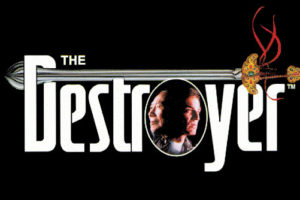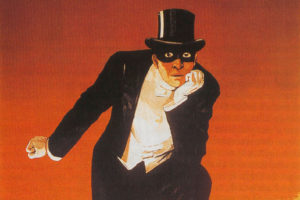How one fictioneer took the controls of an air adventurer.
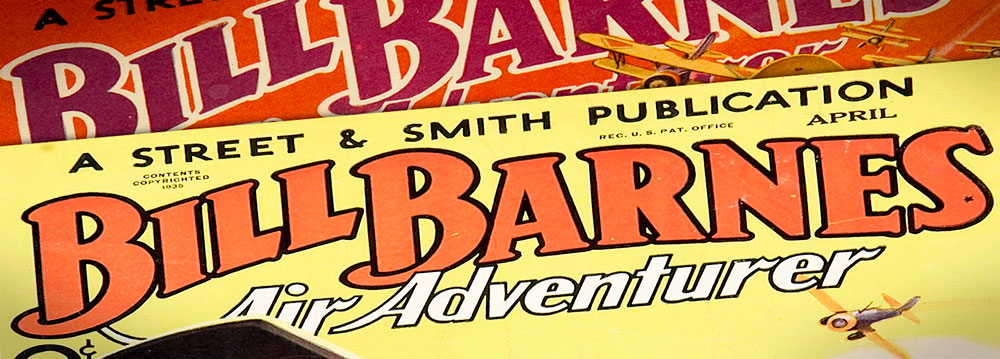
This is the voice of a writer who never really existed. He never wrote a sentence or plotted a story. He was all make-believe. Yet his name appeared on the bible pages of millions of copies of magazines as the author of Bill Barnes, Air Adventurer.
Fanzine flashback
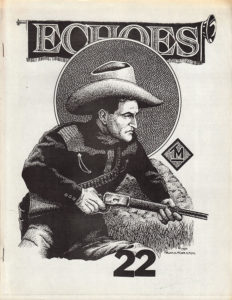
This article originally appeared in Echoes (No. 22, December 1985). It is a transcript of a taped speech played Saturday, July 13, 1985, at Pulpcon 14 in Dayton, Ohio. Republished by permission.
His name, of course, was George L. Eaton, and he was the creation of the Street & Smith Publishing Co. Many publishers of pulp adventure series used a house name instead of the real name of the author. It was convenient. If a writer failed to get his manuscript in on time or should it prove too ghastly to print, there was always a replacement to spring into the breech — with the readers, of course, never aware of the old switcheroo.
Now, my name is Charles “Chuck” Verral. I was one of several George L. Eaton’s, actually the second, following the original, Maj. Malcolm Wheeler-Nicholson. I wrote some 40 or so of the Bill Barnes stories.
As you probably know, I am supposed to be standing here before you in person to say something about Bill Barnes magazine; about the people who edited and produced it; about the readers’ fan club and all that. Unfortunately before I could get to Dayton, I was felled by a vicious bug, spawned without doubt by a descendant of Otto Yahr or some other of Bill’s evil adversaries. Even so, I’d like to chat a bit about the old B.B. days through the magic of this tape deck.
Let’s go back to New York City in the late 1920s and early 1930s. It was a time when the pulps flourished as never before or since. New York had a score or more of publishing companies producing a flood of pulp magazines. There were Street & Smith, Munsey, Clayton, Fiction House, Fawcett, Gernsback, Popular, Thrilling, and many more. As to subject matter, the coverage was complete. There were magazines of love and romance; of science; western; war stories; sea stories; magazines of spies, of detectives, crime and mystery, of sports and aviation. The pay was a penny a word, sometimes as much as two cents.
One thing should be mentioned. The pulp paper magazines were highly moral. The emphasis was on fast action and sound plots. None of your centerfold stuff. The story is told about a Street & Smith editor who was fired because he allowed a story to get into print in which a character ordered breast of chicken for lunch — instead of chest of chicken.
I had left my homeland, Canada, in early 1928 to come to New York to seek a living in commercial art. I had been through a fine-art school in Toronto. But it didn’t take many art turndowns for me to realize that I’d better get into something else. I had heard of the pulsing pulp market but I had no idea what pulps were. I had never read one.
Verral as Eaton
| For over a decade, Charles Spain Verral was one of the fictioneers (including Arch Whitehouse, Harold P. Montanye, and Malcom Wheeler-Nicholson) writing Bill Barnes stories as George L. Eaton. | ||
| “Wings of the Snow Country” | Bill Barnes, Air Adventurer |
July 1934 |
| “The Blood Flower” | Bill Barnes, Air Adventurer |
August 1934 |
| “The Vanishing Dirigible” | Bill Barnes, Air Adventurer |
September 1934 |
| “Flight of the Scarlet Stormer” | Bill Barnes, Air Adventurer |
October 1934 |
| “The Flaming Circle” | Bill Barnes, Air Adventurer |
November 1934 |
| “The Black Scorpion” | Bill Barnes, Air Adventurer |
February 1935 |
| “The Silver Bullet” | Bill Barnes, Air Adventurer |
April 1935 |
| “The Rainbow Gang” | Bill Barnes, Air Adventurer |
August 1935 |
| “Mark of the Vulture” | Bill Barnes, Air Trails |
October 1935 |
| “The Blue Man” | Bill Barnes, Air Trails |
December 1935 |
| “The Black Ghost” | Bill Barnes, Air Trails |
February 1936 |
| “The Curse of the Killer” | Bill Barnes, Air Trails |
April 1936 |
| “Brethren of Death” | Bill Barnes, Air Trails |
June 1936 |
| “The White Pygmy” | Bill Barnes, Air Trails |
August 1936 |
| “The Crimson Line” | Bill Barnes, Air Trails |
October 1936 |
| “Hawks of the North” | Bill Barnes, Air Trails |
January 1937 |
| “The Purple Fez” | Air Trails | March 1937 |
| “The Lancer’s Ready” | Air Trails | July 1937 |
| “The Moon God” | Air Trails | October 1937 |
| “Counterfeit Wings” | Air Trails | December 1937 |
| “The Golden Death” | Doc Savage | September 1939 |
| “The Swoop of the Hawk” | Doc Savage | October 1939 |
| “Nest of the Hawk” | Doc Savage | November 1939 |
| “Formula for Death” | Doc Savage | December 1939 |
| “The Double Mask” | Doc Savage | January 1940 |
| “The Seal of the Salamander” | Doc Savage | February 1940 |
| “The Dragon’s Treasure” | Doc Savage | April 1940 |
| “The Death Dive” | Doc Savage | May 1940 |
| “The Black Arrow” | Doc Savage | July 1940 |
| “The Haunted Sky” | Doc Savage | August 1940 |
| “The Crimson Terror” | Doc Savage | October 1940 |
| “The Squadron of Death” | Doc Savage | February 1941 |
| “The Emerald Dagger” | Doc Savage | April 1941 |
| “The Eye of the Cobra” | Doc Savage | January 1942 |
| “The Spy Master” | Doc Savage | June 1942 |
| “Red Dust of Death” | Doc Savage | October 1942 |
| “Mission to Murder” | Doc Savage | April 1943 |
| “Terror to the North” | Doc Savage | May 1943 |
| “Flight Into Doom” | Doc Savage | June 1943 |
| “The Falling Death” | Doc Savage | September 1943 |
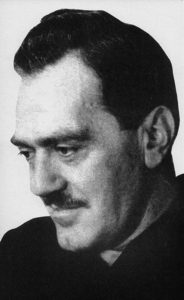
I soon corrected that and, lo and behold, I wrote and sold my first story, “The Luck of the Clouds,” to the magazine, Sky Birds. The fact that I had chosen to write about flying was natural. As a youngster I had grown up in Canada close to a Royal Air Force airdrome during World War I and had spent all my spare time hanging around the flying field, watching the crashes and near-crashes. I became the first kid in town to fly. I was the original air nut and I still am.
Right after my first sale, I sought and got a job with a large pulp paper publisher, Clayton’s. I became an associate editor and read scads of submitted stories and, soon, was locked into the pulp formula.
It was at Clayton’s that I first met F. Orlin Tremaine, a name I’m sure is familiar to many of you as the first editor of Bill Barnes, Air Adventurer. At Clayton’s, Orlin and I worked together on several magazines. We made a good team. Ultimately we went up the ladder — he became pretty much head editor and I became art director.
Then suddenly, as often happened in those days, the Clayton Publishing Co. collapsed, a victim of the depression. Everybody was out of a job.
Right here let me digress. At Clayton’s I had also met another person — Jean — my-soon-to-be bride. Jean had come from the Kentucky Bluegrass seeking to be an editor. She had landed on the Clayton editorial staff. Right after the Clayton demise, Jean and I decided to get married, mainly on the strength of a couple of sport stories I had sold to Argosy. A short time before this event, Jean had switched jobs from Clayton’s to Popular Publications, where she became editor of two magazines (get these titles): Gang World and Underworld Romances.
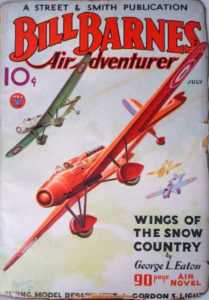
One day I received a phone call from Orlin Tremaine. He had caught on with another big pulp outfit, Street & Smith, and was now editor of a new magazine titled Bill Barnes, Air Adventurer. He asked me to take over the back section of the magazine; to create a fan club, write a few aviation articles and do any art work that was necessary. Thus the readers’ club came into existence. It was called the Flying Falcons, later changed to Air Adventurers. The enrollment was enormous.
I recall one brief scene. I was in Orlin’s office when the receptionist phoned that there were two young boys outside who wanted to join the Bill Barnes Club. One of my duties in the club was that of Flight Cdr. Albert J. Carlson. So Cdr. Carlson went to the reception room to meet the two young recruits. I carried with me, two membership blanks and two membership pins. The boys were maybe 12-years-old, very skinny and very scared.
I escorted them into the Street & Smith conference room — a huge impressive place panelled in oak with a long table down the center of the room, and with glittering chandeliers overhead. I had each little boy raise his hand and take the oath as a member of the club. They could scarcely get out the words. I signed the membership blanks, gave them their membership emblems, shook their hands, and showed them out.

I guess it was funny, those two skinny kids, big-eyed and shivering with excitement. Yet I found myself having to blink more than a few times. I guess it was then that I knew we had something in Bill Barnes; that we had a real following in the kid readers who would stay with us if we stayed with them.
The first five stories about Bill Barnes were written by Major Malcolm Wheeler-Nicholson under the name, of course, of Bill Barnes. A bit later, Orlin told me that there had been a lot of criticism of the Nicholson stories and that it had been decided to get a new Bill Barnes writer, a new George L. Eaton.
I remember Orlin turned to me, looking over his granny glasses and saying calmly, “You’re it!”
I don’t know what I said or screamed. This was crazy. I had little writing experience. I was barely past age 25. And I was expected to write a novel of some 65,000 words long every month!
Well, to cut it short. I had an interview with the Street & Smith biggie, H.W. Ralson and the mantle of George L. Eaton II descended on my quivering shoulders.
My first Bill Barnes novel, July 1934, was “Wings of the Snow Country.” It was followed in August 1934 by “The Blood Flower”; then in September 1934 by “The Vanishing Dirigible.”
Meanwhile Jean and I had run into bad, bad trouble. She had become very ill and when the New York doctors — or those we went to anyway — didn’t seem to be getting anywhere, we packed up and headed for my parents’ home in Toronto, Canada. There Jean fortunately came under the care of a skilled surgeon and, after a serious operation, she began making a comeback. It was suggested that she would be helped along if we moved south to Florida.
We went to Fort Lauderdale for three months and stayed three years.
I had fallen behind schedule and was trying frantically to get back on track. I can only thank good friend and writer, Harold “Monty” Montanye, for taking up the slack.
While Jean was making a slow but steady recovery I wrote a number of Barnes novels, among them “The Black Scorpion.” I’ve been told that some readers consider this the best of the Bill Barnes yarns.
During this time the old pulp paper magazine of Bill Barnes, Air Adventurer was scuttled and replaced by Air Trails, an impressive flat-sized magazine printed on quality paper. The Bill Barnes stories were featured. It seemed to be a good move and I guess it was a first. But I began receiving letters from Orlin about plans that were afoot to change and improve Air Trails. The Street & Smith brass — or so I gathered — believed that the magazine should appeal to an older audience. That indicated more mature plots, more mature characters.
I have been often asked which one of the Barnes crew was my favorite. And without hesitation I always said: Sandy Sanders. Sandy was to me what I had dreamed of as a kid. He did impossible things like engaging in a savage dogfight under the George Washington Bridge; landing his Eaglet on crowded Fifth Avenue; diving headlong in his chute to nail a villain whose plane Bill had shot down but was trying to make a getaway on foot. I was well aware that my views about Sandy were not shared by all editorial hands. Sandy was to them too juvenile, not macho enough, should grow up. The same went more or less for Bill and the other members of his crew.
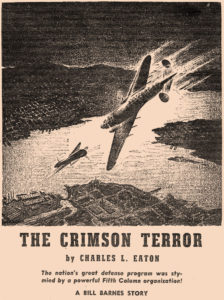
I saw what was coming and expressed my opposition. I said that we were losing the great kid membership that had sold the magazine by making the stories more adult. The showdown was inevitable and I called it quits. My last Bill Barnes story was “Counterfeit Wings,” December 1937. Monty took over the controls and from then on wrote the B.B. stories until March 1939 when Bill Barnes was phased out of Air Trails. And that marked the end of the great aerial adventurer.
But not quite. In the summer of 1939, I was called into Street & Smith and I was informed that it had been decided to revive Bill in shorter form. The stories would have a war background and would appear in Doc Savage Magazine. So once again, I was George L. Eaton. I wrote something like 21 or 22 new Bill Barnes stories — and I loved doing it.
To me, after the end of that Doc Savage series, Bill, Sandy and the others of the Barnes pilots vanished, remembered by very few, I thought. Then, just about a year ago, in 1984, I received a phone call in New York from Boston. It was from Will Murray, who had found my name in a listing in Contemporary Authors. Will gave me the incredible news that, far from ceasing to exist, Bill Barnes and his crew were remembered by many fans, here and in Canada.
I want to express my appreciation for being asked to Pulpcon 1985. I only wish I had been able to get here in person. However, Rusty Hevelin tells me that I’m invited back in 1986 — together with Jean, my bride of 53 years. We intend to make it.
One thing more, if anybody wants information about the Barnes years, just drop me a line. I’ll answer. In fact, drop me a line anyway, I’d like to hear from you.
As to that dogfight I had with Orlin Tremaine, it didn’t last. When Orlin and I were both back in New York, we picked up our friendship where we’d left off. In fact, we worked together in getting out a batch of comic books, among them, A-Man, the Amazing Man, the Liberty Scouts, and others.
So for now, from me to you — cheerio!
About the author
In addition to pulp magazines, Charles Spain Verral also wrote scripts for the Mandrake the Magician radio program from 1940-42, the “Hap Hopper” comic strip, the juvenile book series Brains Benton Mysteries, a number of young readers’ Little Golden Books, and biographies of Robert Goddard, Babe Ruth, and Casey Stengel. He was an editor and writer at Reader’s Digest in the 1960s. He died in 1990 at age 85.


